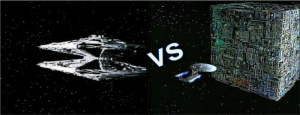Apr 23rd, 2012 by Frank LaBanca, Ed.D.
I’ve recently been hooked on some science fiction series from my earlier years via Netflix. It is quite amazing to be able to watch an entire series from start to finish over a much shorter period of time. The streaming feature is really great. I started my sci-fi adventure with Star Trek Voyager and then moved on to Battlestar Galactica (original series). Both have a common theme – they are far, far away searching for earth. In the case of Galactica, they are somewhere else in the universe searching for the elusive 13th colony – Earth, while Voyager is stranded a bit closer, somewhere across the galaxy, and they know how to get back to Earth – it’s just going to take a while.
So I’ve been thinking about which series I thought was better, and just come to the conclusion that Voyager works better for me on so many levels. Some might think, well the tech from the 70s really isn’t good enough – but I can get by that pretty easily – the constant repeat footage of the vipers and Cylon three passenger vehicles, tube-TV monitors – static when there’s nothing there (instead of the blue screen), keyboards that remind me of Radioshack TRS-80, wired headsets, and all the other “felgercarb.”
What really bothers me in this series is the concept of
They just do such a horrible job in presenting a realistic depiction of distance and time. For example: Earth is presented as “galaxies” away.

Now if galaxies have huge distances between them – the majority of time would be spend traveling between galaxies. However, a transition between galaxies seems to happen almost instantaneously in the show. And don’t forget – these ships all travel at sublight speeds – unlike Voyager that travels at Warp (superlight) speeds. Voyager (located in the same galaxy as Earth) needs to travel 70,000 light years to get home. How far do you have to travel at sublight “flank speed” to make it?
In the final Galactica episode, “The Hand of God,” summarized:
Receiving a mysterious radio signal possibly from Earth, Adama and the crew are wary of a Cylon trap, and decide to turn the tables by attacking the Cylons with a stolen Cylon Raider. Apollo and Starbuck, in the series finale’s last scene, narrowly miss receiving Apollo-11 moon-landing transmissions from Earth.
The Cylon trap is a single ship in the current galaxy, positioned within a single solar system that for some reason the Galactica fleet HAS to traverse. “There’s no way around it.” How can that possibly be that a single ship, hidden behind a single planet of a single solar system in a single galaxy is the ONLY route to go. It just gets too unreasonable for me. The design and thinking is too two-dimensional

This to me is a more interesting comparison. Cylons are
. . . a cybernetic civilization at war with humanity. The Cylons of the 1978/1980 series are not the mechanical foils seen throughout the series, but an advanced reptilian race who created the robots (who were referred to as Cylons within the show) to serve them, maintain their vast empire and to man their military forces in the face of a sudden population drop that eventually led to the Cylons’ extinction — seemingly overnight. (wikipedia)
While the Borg are
. . . a fictional pseudo-race of cybernetic organisms depicted in the Star Trek universe. The Borg manifest as cybernetically-enhanced humanoid drones of multiple species, organized as an interconnected collective, the decisions of which are made by a hive mind, linked by subspace radio frequencies.
The Cylons are certainly a reflection of 70s technology. Each unit is independent and there is a hierarchy of unit type. The silver Centurion is the lowest level and has a seriously computer-processed voice. For a race of “robots,” they are seriously unsophisticated and seem to have pretty poor processors and data nodes. Likely because the technology didn’t exist (in real-time, 1978), it is surprising to see that these cyborgs have no networking capability – there is no data sharing between units, unless communicated orally. The Cylons are unlike the Borg which are all interconnected and simultaneously processing all knowledge and data between units – now that’s sophisticated technology. The Borg are composed of both organic and computer components.
In a battle, who wins? I think the Borg have it hands down – just in ship alone, the Borg cubes have electronic field generating shields – the Cylon Basestars don’t have any shielding.

So thanks for enjoying my SciFi rants. Resistance is futile!